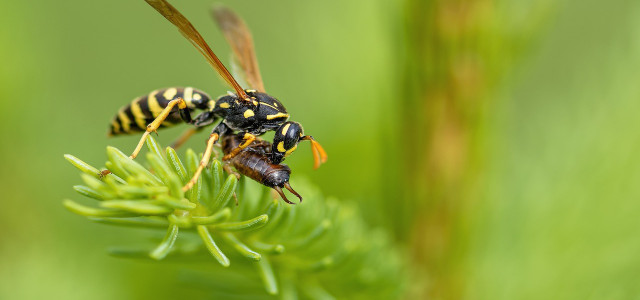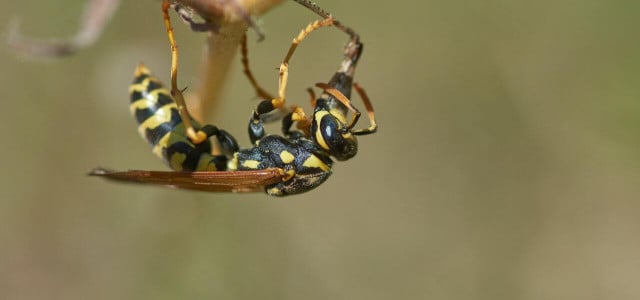Discover the fascinating world of different types of wasps this summer! From Eastern Yellowjackets to Tarantula Hawks, learn about their behaviors, habitats, and danger levels.
Get ready to explore the world of wasps this summer! In this article, we delve into the intriguing behaviors, habitats, and danger levels of different types of wasps. From the social Eastern Yellowjackets to the formidable Tarantula Hawks, we uncover the unique characteristics of each species. Discover which types of wasps to watch out for this summer and gain a deeper understanding of these fascinating creatures.
1. Eastern Yellowjacket
Vespula maculifrons
- Conservation status: Least concern – unlikely to become endangered or extinct in the near future.
- Danger level: Moderate – Eastern Yellowjackets can be aggressive and have a painful sting. They are known to defend their nests vigorously.
This type of wasp is known for its yellow and black coloration, which warns away predators. Eastern Yellowjackets are social insects that live in colonies with a hierarchy. The colonies usually live in underground nests, such as abandoned rodent burrows or other cavities in the ground. The nests are made of chewed wood fibers and saliva, which makes a papery material.
The Eastern Yellowjacket, scientifically known as Vespula maculifrons, is a species of wasp native to North America, specifically the eastern part of the continent. Eastern Yellowjackets are found in a wide range of habitats, including forests, meadows, gardens, and suburban areas. They often find their way into your home, however when that happens you can get rid of a wasp with a few easy-to-follow tips and tricks. Their colonies reach their peak population in late summer and early fall when they are most active during the warmer months.
They feed on nectar and other sweet substances, but they also scavenge for proteins from insects, spiders and carrion. As opportunistic scavengers, they may also like human food and can be a nuisance at outdoor gatherings or picnics. It is best to keep away from their nests and avoid provoking or disturbing them to reduce the risk of getting stung.
2. Bald-faced Hornet
Dolichovespula maculata
- Conservation status: Least concern – unlikely to become endangered or extinct in the near future.
- Danger level: High – Bald-faced Hornets are generally more aggressive than yellow jackets. They have a potent sting and can become defensive when their nests are disturbed.
Despite its name, dolichovespula maculata is not a true hornet, but rather a type of yellowjacket wasp. The Bald-faced Hornet is known for its distinct black-and-white coloration, with most of its body being black and its face and other markings being white. These wasps construct large, paper-like nests, typically found in trees, shrubs, or on man-made structures such as buildings.
They can be found in various parts of the United States, particularly in the eastern and central regions. This includes Maine, New Hampshire, and Vermont, down to the southern states such as Florida and Louisiana, and westward to states like Texas, Oklahoma, and Kansas. Bald-faced Hornets primarily consume nectar and fruit juices, but they also capture and kill other insects to provide protein for their colony.
3. European Paper Wasp
Polistes dominula
- Conservation status: Least concern – unlikely to become endangered or extinct in the near future.
- Danger level: Low – European Paper Wasps are generally less aggressive than yellow jackets or hornets. While their stings can be painful, they are not typically considered highly dangerous.
Polistes dominula is a species of wasp that is not native to North America but has been introduced to the continent. These types of wasps have slender bodies featuring black and yellow coloration, resembling other paper wasp species. They construct open-celled paper nests, often found in protected areas such as eaves, tree branches, or shrubs.
European Paper Wasps have been reported in the northeastern states, including areas of New England such as Massachusetts, Connecticut, and Rhode Island. They have also been observed in the mid-Atlantic region, including New York, New Jersey, and Pennsylvania. They can be found in various habitats, including gardens, urban areas, and natural environments.
4. Red Paper Wasp
Polistes carolina
- Conservation status: Least concern – unlikely to become endangered or extinct in the near future.
- Danger level: Low – Red Paper Wasps are similar to European Paper Wasps in terms of behavior. They are generally less aggressive and their stings are moderate in severity.
Red Paper Wasps are known for their striking red coloration, which distinguishes them from other paper wasp species. The nests are made by chewing plant fibers and mixing them with saliva, forming a papery material. They primarily consume nectar and other sweet substances, but they also capture and paralyze insects to feed the developing larvae within the colony.
The Red Paper Wasp can be found in various regions of the United States. Their range extends across the eastern and central parts of the country, spanning from the southern states such as Florida, Georgia, and South Carolina, all the way northward to states like Ohio, Indiana, and Illinois. This type of wasp is also present in parts of Texas and Oklahoma and can be found in a range of habitats, including woodlands, gardens, and urban areas.
5. Pacific Cicada Killer
Sphecius convallis
- Conservation status: Least concern – unlikely to become endangered or extinct in the near future.
- Danger level: Low – Pacific Cicada Killers are not aggressive toward humans unless directly provoked. Their stings are generally mild and pose minimal danger.
The Pacific Cicada Killers are a species of large solitary wasps known for their size and their distinctive hunting behavior. Primarily black with yellow markings, the females are larger than the males and can grow up to two inches in length. As their name suggests, this type of wasp is specialized in hunting cicadas. The females paralyze cicadas with a venomous sting and then transport them to their underground nests, where they serve as a food source for their developing larvae.
Sphecius convallis is primarily found in the western regions of the United States. Its range extends along the Pacific coast, including states such as California, Oregon, and Washington. It can also be found in parts of Nevada and Arizona. These wasps are often found in open areas such as meadows, gardens, and grasslands, where cicadas are abundant. They prefer sandy or well-drained soil for nesting and can create extensive burrows in the ground.
6. Organ Pipe Mud Dauber
Trypoxylon politum
- Conservation status: Least concern – unlikely to become endangered or extinct in the near future.
- Danger level: Low – Organ Pipe Mud Daubers are solitary wasps that typically do not exhibit aggressive behavior. Their stings are usually mild.
The Organ Pipe Mud Daubers are a species of solitary wasp named after their distinctive behavior of constructing nests using mud, which resembles organ pipes. Each female constructs her own individual nest. The female then captures and paralyzes spiders, stinging them to render them immobile but still fresh for the larvae to feed on.
This type of wasp has been observed in states such as Florida, Georgia, Louisiana, Mississippi, Alabama, Arkansas, Missouri, and Illinois, among others. They are found in various habitats, including gardens, woodlands, and urban areas.
7. Great Golden Digger Wasp
Sphex ichneumoneus
- Conservation status: Least concern – unlikely to become endangered or extinct in the near future.
- Danger level: Low – Great Golden Digger Wasps are solitary wasps that are generally not aggressive towards humans. Their stings are considered mild.
The Great Golden Digger Wasp is a solitary wasp species known for their impressive size and distinctive golden coloration, which gives them their common name. They have slender and elongated body with shiny golden exoskeletons. The wings are transparent with dark veins, adding to their striking appearance.
Sphex ichneumoneus has been documented in states such as Texas, Oklahoma, Kansas, Missouri, Iowa, Illinois, Indiana, Ohio, Kentucky, Tennessee, and many others. As a solitary type of wasp, the females of this species construct individual nests for their offspring. They prefer areas with loose soil or sandy habitats.
8. Red Velvet Ant
Dasymutilla occidentalis
- Conservation status: Least concern – unlikely to become endangered or extinct in the near future.
- Danger level: High – Red Velvet Ants have a highly painful sting. However, they are typically non-aggressive unless provoked.
These intriguing types of wasps are known for their vibrant red or orange-red coloration, dense velvety hair, and striking appearance. Despite their name, Dasymutilla occidentalis is not actually an ant. The females are wingless, so they look like very large ants. Red Velvet Ants are renowned for their powerful sting, and caution should be exercised when encountering them.
These wasps are solitary and can be found in a variety of habitats, including grasslands, meadows, and open woodlands. Specifically, this type of wasp has been observed in states such as Texas, Arizona, New Mexico, Nevada, Utah, California, and parts of the Midwest region.
9. Tarantula Hawk
Pepsis grossa
- Conservation status: Least concern – unlikely to become endangered or extinct in the near future.
- Danger level: High – Tarantula Hawks have one of the most painful wasp stings. However, they are not inherently aggressive towards humans unless handled or threatened.
The Tarantula Hawk is a large and formidable species of solitary wasp known for their impressive size and striking coloration, often featuring black bodies with vibrant orange or rust-colored wings. Tarantula Hawks are renowned for their unique hunting behavior, as their name suggests. The females locate and paralyze the tarantulas using a potent sting to serve them as a food source for the developing wasp larvae.
These types of wasps can be found in arid and semi-arid regions, such as deserts and grasslands. Pepsis grossa has been observed in states such as Texas, Arizona, New Mexico, Nevada, Utah, California, and parts of the Midwest region. They are active during the day and are often observed flying low to the ground in search of tarantulas.
10. Catskill Potter Wasp
Ancistrocerus catskill
- Conservation status: Least concern – unlikely to become endangered or extinct in the near future.
- Danger level: Low – Catskill Potter Wasps are not known for aggressive behavior and their stings are generally mild.
The Catskill Potter Wasps are relatively small types of wasps, typically measuring around half an inch in length. As solitary wasps, each female Catskill Potter Wasp constructs her own individual nest made from mud or clay which resembles a small pot. Once the nest is constructed, the female Catskill Potter Wasp provisions it with paralyzed prey and lays a single egg on the prey item before sealing the nest, ensuring that the developing larva will have a sufficient food supply.
Catskill Potter Wasps can be found in meadows, fields, gardens, and woodland edges within the Catskill Mountains region of New York State. They are particularly attracted to areas with available mud or clay sources for nest construction.
11. Long-tailed Giant Ichneumonid Wasp
Megarhyssa macrurus
- Conservation status: Least concern – unlikely to become endangered or extinct in the near future.
- Danger level: Low – Long-tailed Giant Ichneumonid Wasps are non-aggressive and their stings are typically mild.
The Long-tailed Giant Ichneumonid Wasps are known for their impressive size, with females measuring up to four inches in length, including their long ovipositor, a slender tube-like structure at the end of her abdomen. The female uses it to drill into wood, particularly that of dead or dying trees, in search of the larvae of wood-boring insects onto which she will lay her eggs.
Megarhyssa macrurus has been documented in states such as New York, Pennsylvania, Ohio, Michigan, Illinois, Wisconsin, and parts of the southeastern states. This type of wasp is often observed flying near trees and fallen logs, searching for suitable locations to lay their eggs.
12. Spotted Scoliid Wasp
Scolia dubia
- Conservation status: Least concern – unlikely to become endangered or extinct in the near future.
- Danger level: Low – Spotted Scoliid Wasps are a solitary wasp species and are not aggressive toward humans.
The Two-Spotted Scoliid Wasp is a relatively large type of wasp, measuring about an inch in length. They have robust bodies with shiny black exoskeletons. The most notable feature of these wasps is the presence of two prominent bright yellow spots, giving them their common name.
These wasps can be found in meadows, grasslands, and gardens in states such as Florida, Georgia, Alabama, Mississippi, Louisiana, Texas, Oklahoma, Arkansas, Tennessee, Kentucky, Virginia, West Virginia, Ohio, Indiana, Illinois, Missouri, and Kansas. They are particularly attracted to areas with abundant flowering plants, as they feed on nectar as adults.
13. Great Black Wasp
Sphex pensylvanicus
- Conservation status: Least concern – unlikely to become endangered or extinct in the near future.
- Danger level: Low – The Great Black Wasp is a solitary wasp species not known for aggressive behavior towards humans unless directly threatened or handled.
Great Black Wasps are visually striking, with a shiny black body and iridescent wings. They are important pollinators and play a role in controlling grasshopper populations, making them beneficial insects to have in natural habitats and gardens. The female wasps are solitary and construct underground burrows where they lay their eggs and provision them with paralyzed grasshoppers or crickets.
Great Black Wasps have been documented in states such as Texas, Oklahoma, Kansas, Missouri, Iowa, Illinois, Ohio, Kentucky, Tennessee, and many others. This type of wasp typically inhabits open areas such as meadows, fields, gardens, and grasslands. They are often seen hovering around flowers and vegetation, as they feed on nectar as a source of energy.
Read more:
- Are Praying Mantises Endangered? Facts & Easy Removal Tips
- What Happens if Bees Go Extinct? 10 Things That Would Disappear
- Are Bumble Bees Dangerous? Facts & Safety Tips
Do you like this post?










